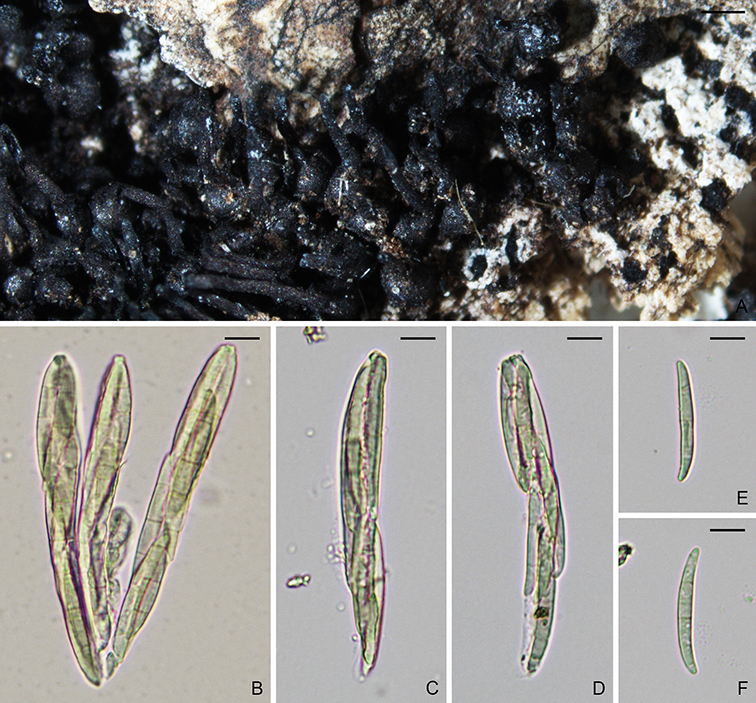
Figure. Ceratosphaerella castillensis (NYBG968642). A. Ascomata. B–D. Asci. E–F. Ascospores. Scale bars: A = 500 µm; B–F = 10 µm.
Ceratosphaerella castillensis (C.L. Sm.) Huhndorf, Greif, Mugambi & A.N. Mill., Mycologia 100(6): 944 (2008).
MycoBank: MB508750.
≡ Ceratosphaeria castillensis C.L. Sm., Bull. Lab. Nat. Hist. Univ. Iowa 2:403. 1893.
Ascomata perithecial, superficial, gregarious, dark brown to black, 450–650 µm diam, with a cylindrical, dark brown to black neck, 500–1000 × 170–280 µm. Paraphyses unbranched, septate, hyaline. Asci 8-spored, unitunicate, clavate, 80–100 × 9–15 µm, with a refractive ring. Ascospores 2–4-seriate in ascus, fusiform, slightly curved, 3-septate, not constricted at septum, hyaline to yellowish, smooth, 29–35 × 3.5–5 µm.
Typification: Lectotype NY, C.L. Smith, Central American Fungi 13. Isotype BPI, C.L. Smith, Central American Fungi 13.
Gene sequences: EU528003 (18S), EU527997 (28S).
Specimens examined: Nicaragua, Castillo Viejo, on bark, Feb.–Mar. 1893, C.L. Smith, Central American Fungi 13 (NY968642, BPI625023, BPI625024).
Hosts/substrates: On bark or wood.
References:
Huhndorf SM, Greif M, Miller AN. 2008. Two new genera in the Magnaporthaceae, a new addition to Ceratosphaeria and two new species of Lentomitella. Mycologia. 100(6):940–955.
Geographical distribution: Costa Rica, Provincia Limon. Puerto Rico, Caribbean National Forest. Nicaragaua, Castillo Viejo.
Copyright 2022 by The American Phytopathological Society. Reproduced, by permission, from Luo, J., and Zhang, N. 2022. The Rice Blast Fungus and Allied Species: A Monograph of the Fungal Order Magnaporthales (https://my.apsnet.org/APSStore/Product-Detail.aspx?WebsiteKey=2661527A-8D44-496C-A730-8CFEB6239BE7&iProductCode=46826). American Phytopathological Society, St. Paul, MN.